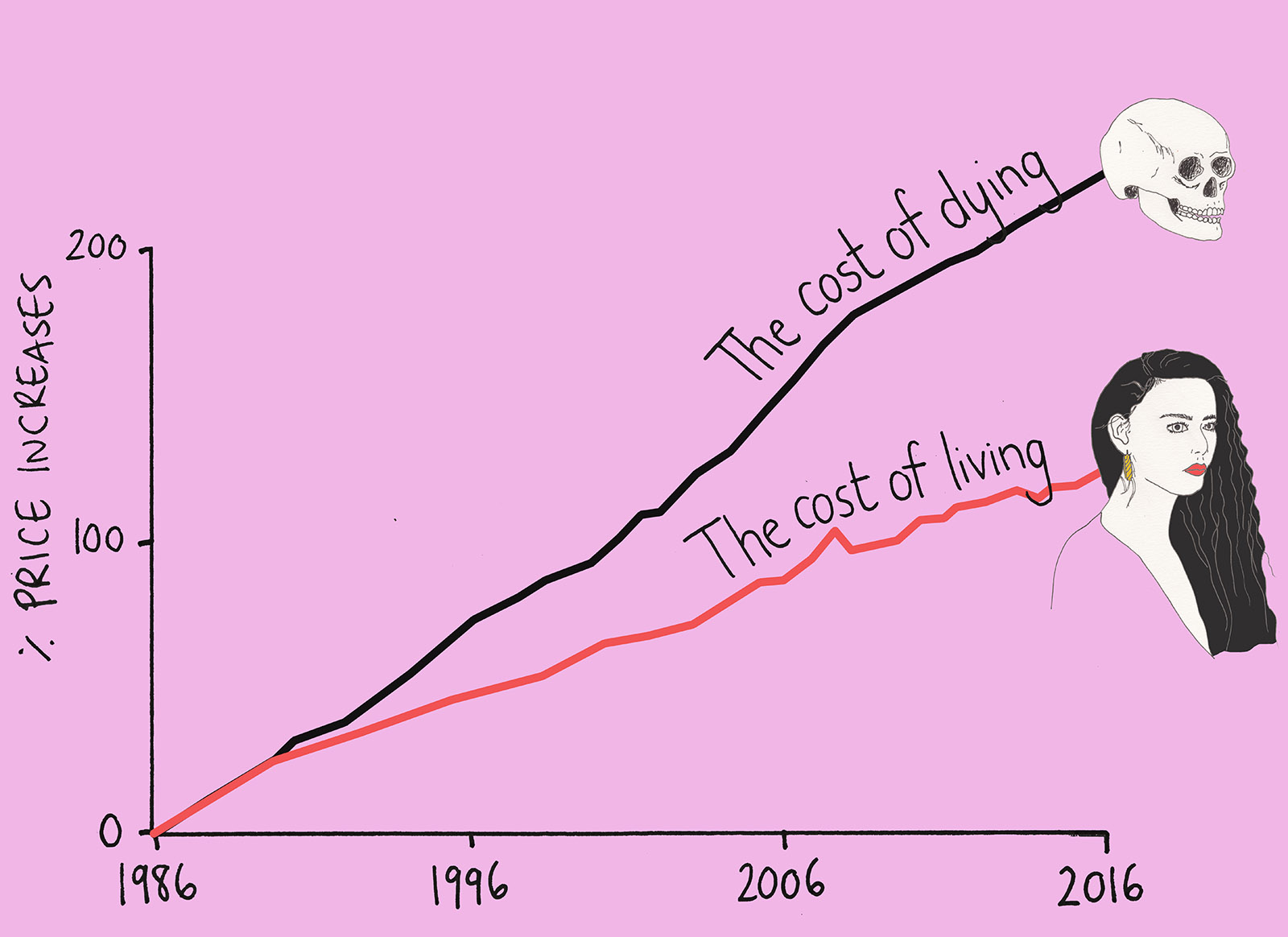
Jerry Burton was a frugal man. So frugal, in fact, that his possession of an organ donor card was motivated by his disdain for waste. While he was still in hospice care, Jerry made it clear to his son and daughter-in-law that they should shop around to get a good deal on his funeral. They did. In total, the transportation of Jerry’s body, the cremation, and the pickleball tournament that he wanted to be held before his service cost $695. Such bargains are a rarity in America’s modern funeral industry.
The median pricetag of a funeral in 2017 was $7,360—a cost that would take the typical US worker five months of labor to cover. Because of these high prices, many families are panicking at the same time that they are grieving.
The death of Kara Killeen’s father was followed by calculations that provide a depressing tally of the average American’s struggles. Student debt bills meant that Kara and her sister had less money in the bank (and much of her dad’s retirement money had gone toward helping them cover those repayments, as well as the family’s mortgage). Limited care provision under Medicare meant that Kara’s mother had lost her job to look after her sick husband (and since her job had been writing for the local newspaper, there wasn’t exactly an abundance of new vacancies for her to apply for later). And, like many American families today, the Killeens don’t all live in the same city, so there were flights to think about, in addition to the funeral costs.
Fortunately, an aunt was able to cover Kara’s flight back from Scotland to Ohio. Unfortunately, the fact that Kara needed an intermediary in another time zone to book her travel meant that she made it back two days after her father’s death. Once reunited, the family looked at their funeral options; they were shocked at the prices they were hearing. A reception in a local bar where her dad had been a regular customer would cost $3,000, including catering. They could have held it at their family home for free, instead, but that wasn’t really viable: Kara had come back to discover the house where her mother had cared for her dying husband was a messy cross between a hospital and a home. An urn would have cost $275, programs $160, and an obituary $200, according to the latest averages from the National Funeral Directors Association.
In the end, with her aunt’s financial support, Kara’s family was able to pay for the cheapest option available: Kara’s father was cremated and his remains were returned to the family in a plastic bag, and there was no funeral. The family still faced a bill for $2,000. “His final mark on the world was just to not have enough money,” Kara told me, bitterly. Funerals are supposed to be a chance to grieve, mourn, and begin the process of emotional recovery after a death; but when money is tight, they can feel like a second trauma.

In the movies at least, funerals are a chance to meet old friends that you didn’t even know that your dearly departed had. To hear stories that you had never heard before. “You expect everyone to be there,” Kara said. We infer much about a life from a funeral. For no service to be held might imply some secret shame. A small gathering might indicate a lack of popularity. Cheap flowers suggest, well, cheapness. Each of these sentences could just as easily apply to another of life’s landmark social gatherings—weddings—except that marriage customs have changed faster than our death customs.
It is a matter of personal prerogative whether a couple spends their life-savings on a Star Trek-themed extravaganza or just heads to city hall with two strangers pulled off the street to act as witnesses. That choice is more likely to be seen as a question of taste rather than of moral character. But when the social occasion requires people to be present to honor someone who is absent, then the rules change.
The desire not to skimp (or at least, to be seen not skimping) leads us to make bad decisions according to Joshua Slocum, the executive director of the Funeral Consumers Alliance, a nonprofit watchdog. “It’s a distressed purchase,” he explained. “No one wants to buy a funeral.” Our decisions are clouded, not just by grief but by the fact that there is no requirement for funeral homes to email you a pricelist or post one on their website. “I can’t think of any other business sector that doesn’t allow you to shop around,” Slocum added. So families will simply choose whichever funeral home they used the last time they had to hold a service.
Advertisement
What those families rarely realize is that their local funeral home, once run as a “mom-and-pop” family business, is now probably owned by a Wall Street firm. Service Corporation International, or SCI, for example, operates 1,477 funeral service locations and 483 cemeteries across the country, and is worth $13.3 billion (for comparison, the countrywide clothing chain Gap Inc. is worth $8 billion). Shareholders expect dividends and they have to come from somewhere: according to Slocum, SCI charges between 40 percent and 75 percent more for its services than independent funeral homes do.

The price of dying is also high because there are simply too many funeral homes. Slocum gives me the example of Montpelier in Vermont, the smallest state capital (by population) in the country. The city has two fully serviced funeral homes that, between them, handle an average of seventy-six deaths a year. These businesses have to keep prices high if they want to cover their mortgages and pay their staff.
I asked Slocum why he became involved in funeral consumers’ rights. He replied simply, “I love Mitford.” It was after reading Jessica Mitford’s classic muckraking polemic on the American funeral industry, The American Way of Death (originally published in 1963), that he became fascinated by the industry and wanted to know more. Little of substance has really changed in the business since Mitford’s book was published except for the escalating prices. Back in 1960, the cost of a funeral was around $700—still a considerable amount of money in real terms, amounting to about seven weeks of a typical worker’s wages at that time (as noted above, by the same measure, today’s figure is at least twenty weeks).
Funeral charges have risen for the same reason that prices have always risen: a disconnect between demand and supply. For a combination of reasons—cost, changing mores, and environmental concerns—more consumers now want their remains and those of their relatives to be burned rather than buried, but the US funeral industry is largely stuck in the past. In fairness, this cultural change has come relatively quickly: in 1960, when Mitford was researching her study, just one in twenty-eight people who died in the US were cremated; today, it’s one in two—half of all funerals. Yet mortician schools still place a heavy emphasis on embalming skills, and more than two thirds of states (thirty-six out of fifty) require funeral establishments to maintain an embalming room (or access to an embalming preparation room); and nearly half of states require a funeral director to be a certified embalmer. Those laws directly contribute to higher prices. In a study published last year, two economists at Kenyon College in Ohio, David E. Harrington and Jaret Treber, calculated that embalming regulations in New York State cost consumers an additional $25.8 million each year.

Although American business traditionally hates regulations, regulating how companies handle and dispose of cadavers makes sense—there are too many public health and public safety considerations involved, let alone consumer rights, for this to be otherwise. “Now, death is seen as an emergency: a dead body has this association of being a biohazard,” explained Caitlin Doughty, who started working in deathcare in 2008 and today owns and runs Undertaking LA. This contrasts sharply with the way a decease was handled 150 years ago, in a pre-industrial era. “Death was a domestic task,” she said. “The women would prepare the body, the men would prepare the casket.”
States began to legislate to control funeral directors around the same time they set professional standards to govern doctors and lawyers, in the mid-nineteenth century. The main aim was to protect the vulnerable—in this case, the bereaved—from charlatans. But many state laws about deathcare now appear outdated or nonsensical. Four states prohibit funeral homes from serving food and beverages entirely, and in New Jersey until very recently, homes could only serve water and peppermints (it is unclear whether such rules arose for reasons of decorum or public hygiene). In five states, funeral directors have exclusive rights to sell caskets, in effect a protectionist measure that blocks cheaper competition—such as Amazon’s “Premium Cardboard Coffin for Adult Funeral,” for just $235.
The outlook seems bleak for customers with few choices and facing high costs. But after sixteen years working in funeral consumer rights advocacy, Slocum doesn’t see it quite this way. “There are two sides to issues like this,” he argues, “and in order to make funerals that are affordable, you need to have both oversight of the industry by the government, but you also need consumers that act with agency rather than being helpless victims.”
It is difficult, though, to think of any other purchase that is quite so unavoidable as paying for a funeral, nor one that demands decision-making at a time when emotional distress is a given. One way to feel empowered in the way that Slocum suggests is to lean, if you can, on your community.
Advertisement

Askia Toure and his two sisters, Sakina and Zahira, were able to turn to the Islamic Society of Greater Houston, Texas, when their mother died of uterine cancer in 2015. The society helped Sakina, who was the only sibling that lived close to her mother when she died, to wash and shroud her mother’s body according to Islamic practice. Two days later, their mother was placed in a plot she had pre-chosen. “That’s how we’ve been raised,” Askia said, “to bury each other with dignity as soon as possible for the least amount of pain or debt inflicted on those who are still here.” When families can’t cover the cost, the community that makes up the membership of the Islamic Society pitches in. Even before Askia’s mother died, the society’s members had contributed to cover the medical costs of her final illness, using a crowdsourcing page.
Crowdfunding for the funerals themselves is now common. Just one site alone, Go Fund Me, boasts that every year it raises $330 million for some 125,000 memorials (a level of contributions that averages out at $2,640, about a third of the typical funeral’s costs). These sites are especially important for families like the Toures because black American households have less wealth than any other racial or ethnic group in the country. When a large, one-off expense like a funeral needs to be paid, the choice facing such families is often brutally simple: ask for help or sell the car.
Even with a community behind you, bargain-hunting is still important. Non-funeral home options are still limited—and, in fact, can often be even more expensive. You can, it is true, order a cardboard casket from Amazon for as little as $235, but then what? Most states have strict laws about where and how you can dispose of a body. Shopping around for professional funeral services is still the better option for most people. “You can find prices that range from $700 to $4,000 for the same basic service,” said Slocum. “The grief will come, but the terror [of financial ruin] doesn’t have to.”
Funerals are hard because they force us to manage a very practical matter that is simultaneously a profoundly emotional one—to make arrangements amid tumultuous feelings. One thing that can help is to have talked to a loved one before she dies about the kind of funeral she’d want. When it was time for the conversation that Jerry Burton wanted about his desire for a cheap send-off, his daughter-in-law, Melody Burton, a marketing and communications manager from Gresham, Oregon, was apprehensive. But it turned out to be a blessing, not a trauma. “You don’t get to talk about things that are so deeply personal like that very often,” she told me. “It was a beautiful time.”



